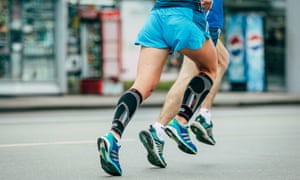
Can ultra-tight-clothing make you a better athlete? Well yes, if the UK’s biggest sportswear brands are to be believed. The sale of compression garments across the webpages of Adidas, Under Armour, Asics and more is almost ubiquitously associated with phrases such as “increase muscle power”, “go further and faster” and “optimise performance”. Going by the revenue generated, such slogans clearly do their job, with the entire compression wear and shapewear market predicted to reach a whopping $5.6bn (£4.4bn) by 2022. Some of this revenue comes from the sale of bodyshapers such as Spanx, but a third comes from sales of compression-wear leggings, socks and stockings. Such is the belief of consumers in the value of these products that they are even prepared to tolerate premium prices, with retail margins for compression garments standing at 46%, compared with 43% for regular sportswear items.
However, a recent study funded by Nike appears to pour cold water on the supposed performance benefits of compression clothing. Putting 20 experienced runners on a treadmill for 30 minutes at 80% of their maximum effort, while completing a series of fatigue tests before and afterwards, they found no difference in the levels of fatigue between those wearing compression garments and those wearing normal shorts.
One of the key measures of the study was muscle vibration, assessed using high-speed cameras tracking the runners’ legs. Muscle vibration, particularly during running, causes micro-traumas or ruptures in the muscle, resulting from the force of the impact when your foot hits the ground. It has long been thought that reducing this could improve your ability to run for longer, at higher speeds, and perform better if you have consecutive bursts of high-intensity exercise – for example, a trail-running competition with races over several days. However, while the Nike study found compression garments did reduce muscle vibration, this had little impact on performance.
To some, this is far from surprising. The scientific community has long thought that compression clothing makes little or no difference to athletic performance. “That’s my personal belief based on the research I’ve read and conducted,” says Dr Jessica Hill, programme director for applied sport and exercise physiology at St Mary’s University, London. “If you wear them to compete in a race, it’s not going to do anything for you. The theory has been that the garments will increase blood flow and therefore oxygen uptake to the working muscle, which could be a benefit. But this hasn’t been scientifically proven.”
Scientists suspect that any benefits felt when wearing compression clothing during exercise may be down to the placebo effect – the large hole left in the wallet from the purchase may leave the wearer willing it to make a difference.
Where compression garments may prove helpful is for post-exercise recovery, particularly in reducing the risk of injury. Their use in this area has a medical origin, with limb compression used in clinical settings to treat a range of inflammatory conditions such as deep vein thrombosis and lymphedema.
“If you exercise, whether you’re working out in the gym or running, you have some microscopic tears in your muscle, and during the repair process you feel some soreness,” says Dr Florian Engel, a researcher at Heidelberg University. “There is some water in your muscle cells and, as soon as you’re passive and you stop moving, the volume enlarges and this causes the pain. The compression works a little bit like a pump, helping to circulate and remove muscle metabolites, enhancing transport and elimination of the water, reducing the space available for swelling, and improving the lymphatic outflow. During exercise, the effect of compression is not strong enough to enhance performance, but it is during recovery.”
It is even possible to measure the beneficial effects of compression during recovery in the blood, through reduced levels of both inflammatory molecules and an enzyme called creatine kinase, which rises after strenuous exercise, or serious skeletal muscle injuries and heart problems. However, to experience any benefit from compression clothing, it is crucial that the compression is within the optimum range. Low levels can be insufficient to modulate blood flow or osmotic pressure, while excessively high levels can have a negative restrictive effect on blood low. “Compression is measured in terms of millimetres mercury, and right now we think a range of 20-30mm mercury is the optimum,” Engel says. “You shouldn’t go more than 30mm mercury, but at 10mm mercury, it doesn’t have any effect. Some manufacturers display the amount of pressure on the clothes, allowing you to see what you’re getting.”
Hill says one of the factors is how well compression clothing fits the wearer. Studies have shown that there is huge variation across consumers of compression clothing, in terms of the amount of pressure they receive from their gear. “The problem is that a lot of the garments that you buy off the shelf are fitted based on somebody’s height and weight,” says Hill. “But if I took 10 people who were all a size medium based on their height and weight, they’ve all got very different body types. Some might have large thighs, some might have large calves. It’s not an accurate way to fit people. So you’re better off if you can find a company that will fit the garments based on something such as limb circumference, which is a little bit more accurate.”
Scientists are now looking into exactly how best to use compression to aid recovery in a sports-specific manner, particularly for sports where athletes have bouts of high-intensity exercise separated by short breaks. “The performance theories are a bit old-fashioned now,” Engel says. “We need to focus on how you can optimise compression for recovery, for example in between periods of an ice hockey match, or between running heats at the Olympics. It has a very relevant role in these cases.”
[Source”GSmerena”]






